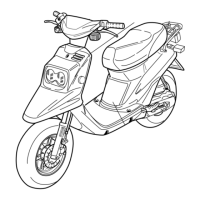CHK
ADJ
BLEEDING THE HYDRAULIC BRAKE SYSTEM
3-20
EAS00133
BLEEDING THE HYDRAULIC BRAKE
SYSTEM
ss
WARNING
Bleed the hydraulic brake system whene-
ver:
• the system is disassembled.
• a brake hose is loosened, disconnected
or replace.
• the brake fluid level is very low.
• brake operation is faulty.
NOTE:
• Be careful not to spill any brake fluid or
allow the brake master cylinder reservoir to
overflow.
• When bleeding the hydraulic brake system,
make sure there is always enough brake
fluid before applying the brake. Ignoring this
precaution could allow air to enter the
hydraulic brake system, considerably lengt-
hening the bleeding procedure.
• If bleeding is difficult, it may be necessary
to let the brake fluid settle for a few hours.
Repeat the bleeding procedure when the
tiny bubbles in the hose have disappeared.
1. Bleed:
• brake fluid
Steps for air bleeding:
a. Add the appropriate amount of brake fluid
to the sump.
b. Install the diaphragm. Take care not to spill
fluid or to let the sump overflow.
c. Connect the clean plastic tube .
d. Place the other end of the tube in a contai-
ner.
e. Slowly apply the brake lever several times.
f. Pull the lever inwards. Keep it in this posi-
tion.
g. Loosen the bleed screw and tighten the
lever as far as it will go.
h. Tighten the bleed screw when it has rea-
ched its limit, afterwards loosen the lever.
i. Repeat steps (e) to (h) until the air bubbles
in the system have been removed.
j. Add brake fluid to the correct level.
WARNING
After bleeding the hydraulic brake sys-
tem, check the brake operation.

